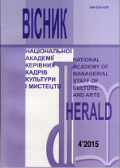GRIGORY SINITSA: THE ART-IMAGE SYSTEM AS A REFLECTION OF THE PERSONALITY OF THE CREATOR
DOI:
https://doi.org/10.32461/2226-3209.4.2015.138448Keywords:
artistic image, individual style, folk art, monumental art, the artist's personalityAbstract
Article is devoted to the study of major aspects of the Grigory Ivanovich Sinitsa activity, a Honored artist of Ukraine, a laureate of Shevchenko state prize. Namely, the process of his individual style forming in monumental painting based on the principles of M. Boychuk school and on the achievements of folk art. Also, he is characterized by an original system of artistic images. The article discusses the factors that influenced the formation of the master’s worldview. In his work, author relied on the methodological principles of the study of artistic creativity, used the newly discovered archival materials – letters of Gregory Sinitsa to his friend, the artist Gennady Marchenko.
Since his youth and during his life artist G. Sinitsa felt a high mission of an artist, who is able to deeply comprehend the significance of important events in the history of country and its people. Moreover, he managed to translate them into meaningful, significant artistic shapes that were close and clear to people.
Training in the studio of monumental painting, founded by Mikhail Boychuk, defined the life path of the artist. He sought to educate a new generation of professional artists, which could create a new, national art. The motto of M. Boychuk: "Service to mankind, but not matter" has become the motto also of the Grigori Ivanovich, who dedicated his life to the creation of modern national art during all. Artistic shapes of G. Sinitsa’s works embodied an influences of time, dreams and hopes of the people, because the artistic shape is the principal method of artistic reflection of reality.
Artistic shapes have certain properties and characteristics. They combine the sensual and logical, subjective and objective, general and single.
The creation of the artwork begins with exploration and realization of design: picturesque plastic motive can become a main idea. The idea is the most important stage of the creative process, which is manifested as intuition, imagination, the particular creative thinking of the author.
The artist has always tried to implement general interests, human perceptions, feelings, thoughts. Characters of G. Sinitsa are people of high moral ideals, fighters for the happiness and freedom of their people. They are full of great mental energy and spiritual power ("Duel" 1970, "Baida" 1968, " Кozhemyaka the winner" 1980, "Prometheus" 1966). For a more vivid realization of his plan G. Sinitsa depicts the sharp edge, culmination moment: collision with enemy forces ("Кozhemyaka the winner ", 1980), the tragedy of the war events ("Babyn Yar", 1984), the triumph of ideas ("Promote", 1966). The depth and drama of the master’s works help to implement the coloring, connecting the expression with spirituality and creative composition. His methods of stylization, generalizations lead to images symbolization. The artist often uses symbols-allegories and symbols-metaphors. In symbols-allegories he expresses abstract concepts through associative close objects and images. For example, stone women from "Polovetskie Madonna" (1974) is represented by symbols of eternity and continuity of time. In symbols-metaphors, comparing with different objects and phenomena, the exchange of their qualities takes place, which gives a new meaning: in the painting "Self-portrait. Lavra" (1976) the beautiful white birds in the sky become a dream of the artist.
G. Sinitsa’s symbolic art images are inextricably linked with folk art; they are close to popular notions of his poetry, metaphors. It seems, that the images of eagles soaring high in the sky in the painting "Khortytsya", came from the folk songs. Upon reaching artistic maturity, the artist with an established worldview creates his own style in art. Creative style is a lasting system of certain expressive means, the range of original artistic shapes that embody the personality of the artist as a thinker and creator. In this case, there is neither borrowing nor eclecticism, because the personality of a great artist is unique and his style is unique too. The style, therefore, is understood as the highest level of skill, as the absolute fusion of work with ideal, conceived by the artist.
The formation of G. Sinitsa’s creative style occurred for many years. In the process of artistic activity were the searches in the field of composition, color, expressive and representational resources. By the 1960s creative artist’s style became defined, which was manifested in the creation of balanced, generalized tracks, where color became the most important expressive mean.
Sinitsa’s creative style is based on the development of folk art traditions: on the identification of the original forces of color as inherent properties of objects, emotions, and creative development of compositional principles of the M. Boichuk’s monumental painting school.
The created artistic shapes are significant, extremely expressive, with a powerful charge of spiritual energy. They embodied ideas of humanistic values of mankind. However, they became close, understandable to contemporaries and have filled their lives with beauty and goodness.
Downloads
Published
Issue
Section
License
Authors who publish with this journal agree to the following terms:
1. Authors retain copyright and grant the journal right of first publication with the work simultaneously licensed under a Creative Commons Attribution License that allows others to share the work with an acknowledgement of the work's authorship and initial publication in this journal.
2. Authors are able to enter into separate, additional contractual arrangements for the non-exclusive distribution of the journal's published version of the work (e.g., post it to an institutional repository or publish it in a book), with an acknowledgement of its initial publication in this journal.
3. Authors are permitted and encouraged to post their work online (e.g., in institutional repositories or on their website) prior to and during the submission process, as it can lead to productive exchanges, as well as earlier and greater citation of published work (See The Effect of Open Access).


